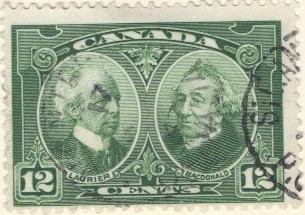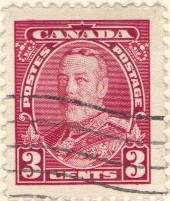





Note: on my website many of the
pictures can not be seen! They are of course present in the cd's;
contact me if you want to purchase them: evert@klaseboer.com.
For stamps of Canada issued before 1900, click here.
1 c green 2 c red 5 c blue 7 c green 10 c brown 20 c green 50 c violet
These stamps have perforation 12. The 2 c value should have been used bisected in 1909, surcharged with a large '1' and a 'POSTMASTER' cancel. However, I have never seen this stamp. The 2 c also seems to exist imperforate.
Value of the stamps |
|||
vc = very common c = common * = not so common ** = uncommon |
*** = very uncommon R = rare RR = very rare RRR = extremely rare |
||
| Value | Unused | Used | Remarks |
| 1 c | c | vc | |
| 2 c | c | vc | |
| 5 c | * | vc | |
| 7 c | * | c | |
| 10 c | * | c | |
| 20 c | ** | * | |
| 50 c | *** | ** | |

1 c stamp with precancel 'QUEBEC QUE.'
1/2 c black (King George V and Queen) 1 c green (Cartier and Champlain) 2 c red (portrait of King and Queen) 5 c blue (L'abitation de Quebecq) 7 c olive (Montcalm and Wolfe) 10 c violet (Quebec in 1700) 15 c orange (partement pour l'ouest) 20 c brown (arrivee de Cartier - Quebec 1535)
These stamps are perforated 12.
Value of the stamps |
|||
vc = very common c = common * = not so common ** = uncommon |
*** = very uncommon R = rare RR = very rare RRR = extremely rare |
||
| Value | Unused | Used | Remarks |
| 1/2 c | c | c | |
| 1 c | c | c | |
| 2 c | c | vc | |
| 5 c | * | * | |
| 7 c | * | * | |
| 10 c | * | * | |
| 15 c | ** | ** | |
| 20 c | ** | ** | |
1 c green 1 c yellow 2 c red 2 c green 3 c red 3 c brown 4 c yellow 5 c blue 5 c violet 7 c olive 7 c brown 8 c blue 10 c brown (two shades of brown exist) 10 c blue 20 c green 50 c black 1 $ red Surcharged


(reduced sizes)
'2 CENTS' on 3 c red (2 types) With inscription 'War tax' added (1915)
1 c green 2 c red Overprinted 'WAR TAX' (1916)
5 c blue 20 c green 50 c black (overprint in red) With inscription 'ITC' added (1916)
2 c red 2 c brown
The perforation of most of these stamps is 12. There are two types of the ITC stamps; differing in the bottom part of the 'T'.
Value of the stamps |
|||
vc = very common c = common * = not so common ** = uncommon |
*** = very uncommon R = rare RR = very rare RRR = extremely rare |
||
| Value | Unused | Used | Remarks |
| 1 c green | c | vc | |
| 1 c yellow | c | vc | Exists imperforate |
| 2 c red | c | vc | |
| 2 c green | c | vc | Exists imperforate |
| 3 c red | c | vc | Exists imperforate |
| 3 c brown | c | vc | Exists imperforate |
| 4 c | c | c | |
| 5 c blue | c | vc | |
| 5 c violet | c | vc | |
| 7 c olive | c | vc | |
| 7 c brown | c | c | |
| 8 c | c | c | |
| 10 c brown | * | c | Two shades of brown were issued: violet-brown and light-brown. |
| 10 c blue | * | c | |
| 20 c | * | c | |
| 50 c | * | c | Exists imperforate |
| 1 $ | ** | c | |
| Surcharged | |||
| 2 c on 3 c | * | * | Both types |
| War Tax | |||
| 1 c | c | vc | |
| 2 c | c | vc | |
| 5 c | *** | *** | |
| 20 c | ** | ** | |
| 50 c | ** | ** | |
ITC |
|||
| 2 c red | c | vc | |
| 2 c brown | c | vc | |
Perforated at two sides:
The values 1 c yellow, 1 c green, 2 c green, 2 c red, 2 c green, 3 c red, 3 c brown, 3 c red and 5 c violet exist imperforated horizontally or vertically (with perforation 8). They were issued in roles for automatic vending machines.


These forged overprints are often wrongly attributed to Andre Frodel. the right one has a triple
surcharge
The following information was passed to me by Ken
Pugh concerning the above forgeries:
"Frodel never worked with overprints. There is quite a
story to these. Fred Eaton, a prominent Vancouver
dealer and benefactor to Frodel, was in possession of the
Frodel estate (including a stock of his forgeries) when the
Vancouver Police was investigation Frodel's forgery activities.
To avoid a problem, he backstamped the Frodel forgeries in his
possession FORGERY or FAKE ANDRE FRODEL. As Eaton, has in
his possession other forgeries from other makers (also his
friends) he backstamped those two. These included many
overprints, OHMS and G officials, even some perfins. The maker of
these "Frodels" was probably Alex MacMaster, a
Vancouver printer and friend of Eaton. I suspect
"Frodels" are being backstamped to this day to satisfy
the forgery collector market."
3 c brown
This stamp is perforated 12.
Value of the stamps |
|||
vc = very common c = common * = not so common ** = uncommon |
*** = very uncommon R = rare RR = very rare RRR = extremely rare |
||
| Value | Unused | Used | Remarks |
| 3 c | c | vc | |
1 c orange (Macdonald, small sized stamp) 2 c green (assembly) 3 c red (parliament building) 5 c violet (Laurier, small sized stamp) 12 c blue (map of Canada)


5 c violet (McGee, small sized stamp) 12 c green (Laurier and Macdonald) 20 c red (Baldwin and La Fontaine)

1 c orange 2 c green 3 c red 4 c yellow 5 c violet 8 c blue
The 1 c and 2 c exist with imperforate top and bottom.
10 c green (Rocky Mountains) 12 c grey (bridge) 20 c red (grass cutting machine) 50 c blue (ship) 1 $ green (parliament building)

1 c orange 1 c green 2 c green 2 c red 2 c brown (1931) 3 c red (1931) 4 c olive 5 c violet 5 c blue 8 c blue 8 c orange Surcharged '= 3 =' on 2 c red (1932)
The values 1 c and 2 c (all colours) exist with imperforate bottom and top (see image above).

12 c black 13 c violet (design as 12 c, 1932) 20 c red (agricultural machine) 50 c blue (first settlement) 1 $ green (Mount Edith Cavell) Overprinted 'WORLD'S GRAIN EXHIBITION & CONFERENCE REGINA 1933' in blue 20 c red (1933)

10 c green.

10 c green

3 c red (as postage stamp, but additional inscription 'OTTAWA CONFERENCE') 5 c blue (Prince of Wales?) 13 c green (large sized stamp, female figure sitting between two globes)
1 c green 2 c brown 3 c red 4 c light brown 5 c blue 8 c red
The 1 c, 2 c and 3 c exist with imperforate bottom and top (coil stamps).
5 c blue (view of Ottawa)
5 c blue
5 c blue
10 c green
2 c red


1 c green (Princess Elizabeth, small sized stamp) 2 c brown (Duke of York, small sized stamp) 3 c red (King George V and Queen Mary) 5 c blue (Prince of Wales, small sized stamp) 10 c green (Windsor castle) 13 c blue (yacht Brittania)

1 c green 2 c brown 3 c red 4 c orange 5 c blue 8 c orange
The 1 c, 2 c and 3 c exist imperforate at bottom and top.
10 c red (policeman on horse) 13 c violet (confederation Charlottetown 1864) 20 c green (Niagara Falls) 50 c violet (parliament buildings, Victoria B.C.) 1 $ blue (Champlain monument)

1 c green 2 c brown 3 c red 4 c yellow 5 c blue 8 c orange
The 1 c, 2 c and 3 c exist imperforate at bottom and top.

3 c red
10 c red (internal of a church) 13 c blue (view) 20 c brown (building) 50 c green (view) 1 $ violet (building)
1 c green (Princess Elizabeth and Princess Margaret Rose) 2 c brown and black (statue) 3 c red and black (King George VI and Queen Elizabeth)

1 c green 2 c brown 3 c red 3 c lilac 4 c red 5 c blue

1 c green 2 c black 2 c olive 3 c lilac (design as 2 c) 4 c red (shades) 5 c blue
Later issues, with the portrait of Queen Elizabeth II: